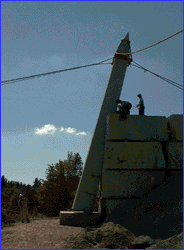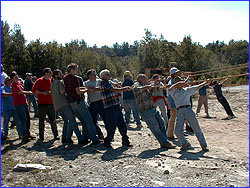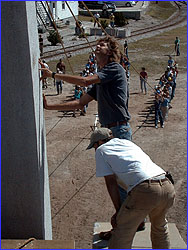
|
 |
 |
by Peter Tyson September 12, 1999 From the moment yesterday morning when I stepped into Fletcher Granite, the quarry in Chelmsford, Massachusetts that was graciously hosting NOVA's attempt to raise an obelisk, I was on a mission, and not a very kind one at that. It wasn't something I did intentionally, or even consciously. But as soon as my boots crunched on the gravel path leading into the quarry, I began searching for some chink in the armor, some flaw in the design, some forgotten, seemingly trivial detail that Rick Brown and his exacting team had missed in their preparations for hauling the obelisk the last 15° to upright. Partly it had to do with the fact that the first half of this operation - getting the obelisk to 75° - had gone so swimmingly that I began to have adrenalin withdrawal by the end of the day. (Though it ultimately came up short, the obelisk-raising attempt in Egypt last march did have its moments of blood-pumping excitement.) I didn't want to suffer that again, nor, I knew, did Julia Cort, who is making a film for NOVA about this attempt. But mostly my suspicions arose from having watched, in person and on film, two previous attempts to erect an obelisk in Egypt come up short, and knowing that those crews had put as much mental and physical effort into their respective undertakings as this one had. So, first I had to find out what Brown and Company had in mind for the raising. Predictably, it proved as clean and elegant in design as a Henry Moore sculpture: Four teams of 28 rope-pullers apiece would pull on four ropes stretching out more or less in parallel from the tip of the obelisk to a point about 100 feet away in the opposite direction to its lean. Meantime, on the other side of the obelisk, Jim Kricker and Al Anderson would carefully ease off on the braking ropes running back to the big braking timbers, while Joel McCarty - who heads up the Timber Framers Guild when he's not raising obelisks—would keep his eye on two other ropes tied off tautly on either side.
But the team's conscientiousness only fueled my desire to turn up something not thought of. I began probing: "Joel," I said, sidling up to McCarty, "are you afraid the pullers might just yank the obelisk right over?" "Hell yes!" he said, grinning through his gray-flecked beard, and then began reeling off figures. It will take 4,800 pounds of pull to get the obelisk moving, he said, but that number will drop off rapidly once the stone is underway. When it gets to an angle of 83°, the obelisk's center of gravity will pass over the point where the rock's butt end rests on the edge of the turning groove, and the force on the braking ropes will increase exponentially, since it will then equal the mass of the obelisk times its velocity squared. Thus, for every doubling of the obelisk's rotation speed, the force on the braking ropes will increase four times. "If the gentlemen at the braking ropes are sleeping," he said, "the obelisk will accelerate at the falling-body rate of 32 feet per second per second." McCarty went on and on, staring me down in a perfectly kind way and smiling. Okay, I thought, so they've worked out the figures if all goes to plan, but what if one group of pullers pulls harder than the others? I asked Rick Brown. "If you'll look closely, you'll see we braided the four ropes near the tip of the obelisk," he said, pointing. He didn't need to explain: any out-of-sync pulling would have no effect on the obelisk. Could it tip to one side or the other?
I was getting concerned; my mission was endangered. Then Wyly Brown told me he'd heard the critical angle was 86.5°, not 83°. Aha, I gloated secretly, now I've got something to work with. I announced the discrepancy to one of the timber framers. "Oh, it's 86 and a half now?" he said, laughing. "Ed must have rejigged the numbers." Not willing to give in so easily, I approached Ed Levin, the mathematician-turned-timber framer who was in charge of working out the engineering numbers. "Oh, I recalculated it to account for the butt end resting in the turning groove rather than right on the pedestal stone," he said, smiling like all the others. "Eighty-six-and-a-half degrees is indeed the point where the obelisk will become self-righting and"—he brought one hand down on the other - "will want to go kerplunk." Confidence in his calculations oozed from him like sweat. Growing desperate, I walked up to Grigg Mullen, the barrel-chested engineer. "Grigg, couldn't something go horribly wrong?" I asked, hoping my jocular tone might jar something loose. "Well, it could spin out of control," he said. He put a meaty hand on my shoulder. "Remember when you were in camp, and you played that game where you tried to raise a bottle off the ground with a wire, and it started spinning out of control?" No. "Could happen here," he continued, and grinned. He couldn't have looked more unconcerned. "Of course, Mr. Murphy's always there." That grin again. Continue Explore Ancient Egypt | Raising the Obelisk | Meet the Team Dispatches | Pyramids | E-Mail | Resources Classroom Resources | Site Map | Mysteries of the Nile Home Editor's Picks | Previous Sites | Join Us/E-mail | TV/Web Schedule About NOVA | Teachers | Site Map | Shop | Jobs | Search | To print PBS Online | NOVA Online | WGBH © | Updated November 2000 |
 The NOVA Obelisk swinging through 15° to
vertical.
The NOVA Obelisk swinging through 15° to
vertical.
 The pullers go at the ropes during one of several
test runs.
The pullers go at the ropes during one of several
test runs.
 With the 100-plus rope gang behind them, Jim Kricker
(standing) and Wyly Brown check for movement in the
obelisk.
With the 100-plus rope gang behind them, Jim Kricker
(standing) and Wyly Brown check for movement in the
obelisk.